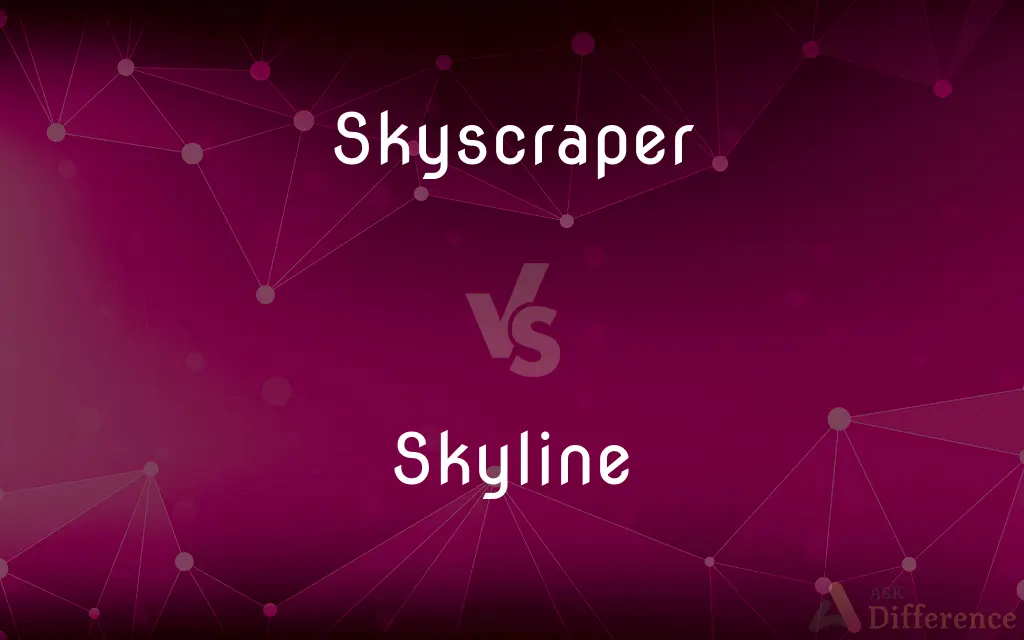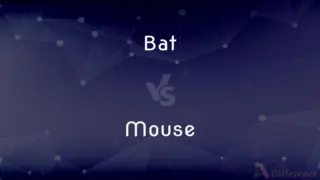Skyscraper vs. Skyline — What's the Difference?
By Urooj Arif & Fiza Rafique — Updated on March 19, 2024
A skyscraper is a tall, continuously habitable building often used for office, residential, or commercial purposes, whereas a skyline is the outline or silhouette created by a city's buildings against the sky, including skyscrapers and other structures.

Difference Between Skyscraper and Skyline
Table of Contents
ADVERTISEMENT
Key Differences
Skyscrapers are architecturally significant buildings that stand out due to their height and design, primarily found in urban centers. They are engineered to be tall and slender, allowing for efficient use of space in densely populated areas. Skyscrapers can be iconic, defining elements of a city's architectural character and often employ innovative construction techniques to reach their towering heights. In contrast, a skyline represents the overall visual profile of a city or urban area, comprising not just skyscrapers but a variety of buildings of different heights, shapes, and purposes. It's the collective appearance of all these structures, as seen from a distance, that creates a unique silhouette for each city.
While skyscrapers are individual buildings, the skyline is a collective image that changes depending on the viewer's perspective and the city's development. The addition of new skyscrapers can significantly alter a city's skyline, reflecting its growth and evolution over time. Conversely, the skyline gives context to individual skyscrapers, showcasing how they contribute to the overall aesthetic and identity of the city.
Skyscrapers are marvels of modern engineering and architecture, designed to withstand natural elements like wind and earthquakes through advanced structural techniques. The skyline, however, is a visual representation of a city's architectural diversity, including historical buildings, modern skyscrapers, and everything in between, offering a snapshot of its development through time.
In terms of functionality, skyscrapers often contain offices, residences, hotels, and retail spaces, serving multiple purposes within a compact footprint. The skyline does not have a functional purpose in the same sense but serves as an important symbol of a city's identity, economic status, and aesthetic appeal, often featured in artwork, photography, and promotional materials.
Understanding the distinction between skyscrapers and skylines is essential for appreciating urban architecture and planning. While skyscrapers are individual entities that challenge the limits of engineering and design, skylines represent the collective identity of urban landscapes, shaped by a variety of structures that together form a memorable visual impression.
ADVERTISEMENT
Comparison Chart
Definition
A tall, continuously habitable building of significant height.
The overall outline created by a city's buildings against the sky.
Composition
Individual building.
Collection of various buildings, including skyscrapers.
Purpose
Primarily for office, residential, or commercial use.
Represents the visual identity of a city or urban area.
Engineering
Requires advanced construction techniques for height and stability.
Not applicable; refers to a visual phenomenon.
Impact
Defines the architectural character of urban areas.
Reflects the growth, evolution, and identity of a city.
Compare with Definitions
Skyscraper
A tall building that significantly stands out in a city's landscape.
The new skyscraper dominates the downtown area with its innovative design.
Skyline
Represents the collective appearance of various structures.
The skyline includes the old church spires alongside modern skyscrapers.
Skyscraper
Reflects architectural trends.
This skyscraper's glass facade reflects the latest in urban architectural design.
Skyline
Can be iconic and unique to a city.
The skyline is instantly recognizable and often depicted in travel brochures.
Skyscraper
Engineered for height and stability.
The skyscraper's design incorporates cutting-edge technology to withstand earthquakes.
Skyline
The silhouette of a city's buildings against the sky.
The city's skyline at sunset is a breathtaking sight.
Skyscraper
Can significantly alter a city's skyline.
The addition of several skyscrapers has transformed the city's skyline over the past decade.
Skyline
Changes with urban development.
The skyline has evolved rapidly with the city's growth.
Skyscraper
Often a symbol of economic power.
The city's tallest skyscrapers are home to major corporations and luxury apartments.
Skyline
Serves as a symbol of the city.
The skyline, with its famous buildings, embodies the spirit and ambition of the city.
Skyscraper
A skyscraper is a tall continuously habitable building having multiple floors. Modern sources currently define skyscrapers as being at least 100 metres or 150 metres in height, though there is no universally accepted definition.
Skyline
A skyline is the outline or shape viewed near the horizon. It can be created by a city's overall structure, or by human intervention in a rural setting, or in nature that is formed where the sky meets buildings or the land.
Skyscraper
A very tall building.
Skyline
The line along which the surface of the earth and the sky appear to meet; the horizon.
Skyscraper
(architecture) A very tall building with a large number of floors.
Skyline
The outline of a group of buildings or a mountain range seen against the sky.
Skyscraper
A small sail atop a mast of a ship; a triangular skysail.
Skyline
(earth sciences) The line at which the earth and sky meet.
Skyscraper
(figuratively) Anything very tall or high.
Skyline
The horizontal silhouette of a city or building against the sky.
Skyscraper
A skysail of a triangular form.
Skyline
A path of movement, especially military movement, producing a silhouette above terrain features visible from the location of likely observers.
Skyscraper
A very tall building with many stories
Skyline
(journalism) A panel on the front page of a newspaper outlining some of the features to be found inside.
Skyline
(database) skyline operator
Skyline
To outline something against the sky.
Skyline
To filter by means of the skyline operator.
Skyline
The outline of objects seen against the sky
Skyline
The line at which the sky and Earth appear to meet
Common Curiosities
Can a skyline exist without skyscrapers?
Yes, a skyline can exist without skyscrapers, especially in cities with lower building heights, but it may be less defined.
What is a skyscraper?
A skyscraper is a tall, slender building designed for residential, commercial, or office use, notable for its significant height and engineering.
How do skyscrapers affect a skyline?
Skyscrapers can dramatically alter a skyline by adding new, towering elements that stand out and change the visual balance of the cityscape.
What defines a skyline?
A skyline is the visual profile or silhouette of a city's buildings, as seen against the sky, representing its architectural diversity.
What role do skyscrapers play in the economy?
Skyscrapers often house businesses, luxury residences, and retail spaces, playing a key role in the urban economy by centralizing activities.
How do architectural styles influence a skyline?
Architectural styles influence a skyline's appearance by introducing varied building shapes, heights, and designs, contributing to the city's visual diversity and identity.
Why are skyscrapers important to urban areas?
Skyscrapers are important for efficiently utilizing vertical space in crowded urban areas, offering extensive floor space in a compact footprint.
What factors contribute to the evolution of a skyline?
Factors include urban development, economic growth, architectural trends, and historical preservation, all of which influence how a skyline changes over time.
Can the skyline of a city change?
Yes, a city's skyline can change with the construction of new buildings, demolition of old ones, and overall urban development.
How is a skyline used in art and media?
Skylines are often used in art, photography, and media to symbolize a city's identity, showcase its architectural beauty, and evoke a sense of place.
How do you capture a city's skyline?
Capturing a city's skyline typically involves finding a vantage point that offers a wide, unobstructed view of the city against the sky, especially during sunrise or sunset for dramatic lighting.
What makes a skyline iconic?
An iconic skyline is characterized by distinctive buildings, historical structures, and a unique arrangement that makes it instantly recognizable.
Are all tall buildings considered skyscrapers?
Not all tall buildings are considered skyscrapers; the term typically applies to exceptionally tall structures that stand out in their urban context.
Why do some cities have more skyscrapers than others?
Economic factors, population density, real estate values, and urban planning policies all influence the number of skyscrapers in a city.
Share Your Discovery

Previous Comparison
Cosinusoidal vs. Sinusoidal
Next Comparison
Bat vs. MouseAuthor Spotlight
Written by
Urooj ArifUrooj is a skilled content writer at Ask Difference, known for her exceptional ability to simplify complex topics into engaging and informative content. With a passion for research and a flair for clear, concise writing, she consistently delivers articles that resonate with our diverse audience.
Co-written by
Fiza RafiqueFiza Rafique is a skilled content writer at AskDifference.com, where she meticulously refines and enhances written pieces. Drawing from her vast editorial expertise, Fiza ensures clarity, accuracy, and precision in every article. Passionate about language, she continually seeks to elevate the quality of content for readers worldwide.














































